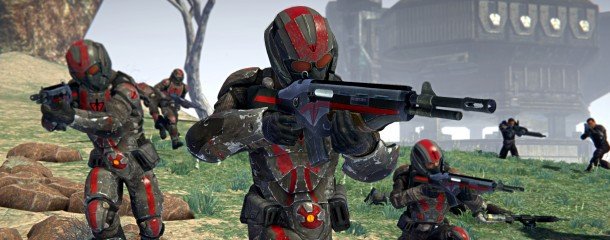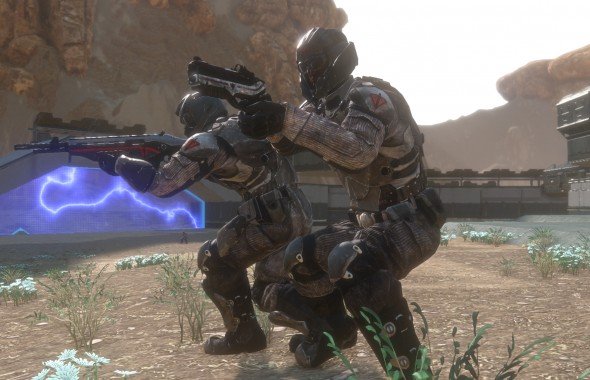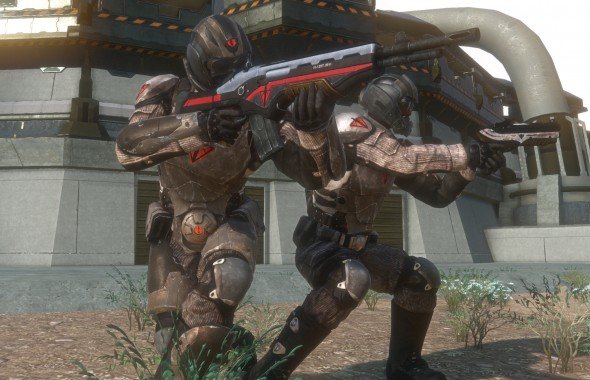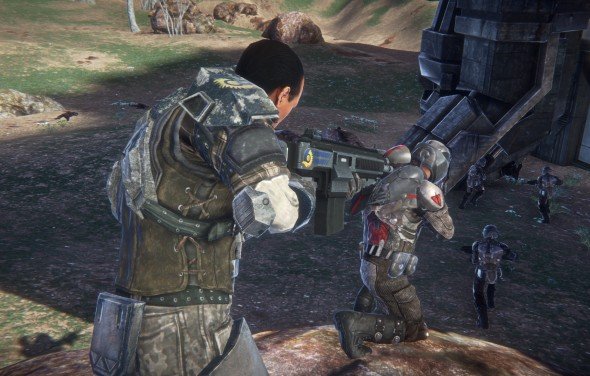Planetside 2 preview

This article originally appeared in PC Gamer UK issue 232.
Matt Higby isn't surprised there aren't more massively multiplayer shooters out there. “They're fucking hard to make.” What surprises PlanetSide 2's creative director is the lack of attempts by other developers to emulate 2003's ultra-ambitious PlanetSide. “You talk to anyone who was a PlanetSide player, they'll go all misty eyed.”
Fellow ex-players, please join me in a spot of eye-misting. I played PlanetSide for a year after the game's launch, seeing the same potential in the game that Higby still eulogises today. “It's an excellent team-based game, it has a lot of action and it's just cool being able to hold a tower with 50 people when 200 people are coming in to it. You can't compare it to anything else.”
Except, now you can compare it to PlanetSide 2. Like the first game, PlanetSide 2 is set in the midst a global war between three factions: the freedom-loving New Conglomerate, the totalitarian Terran Republic and the alien-fancying Vanu Sovereignty. Each of the factions has access to a wealth of guns, gadgets and vehicles, used to wrest control of the continents of the planet Auraxis. From hundreds clashing over a base in the centre of the most contested continent, to five-man scraps over a tower out in the wilderness, all this will be familiar to players of the original PlanetSide.
But for me, that PlanetSide, for all its glittering potential, never quite worked. Playing it in 2003, I wasn't just fighting off Matt's 200 attackers from my tower, I was also fighting against two more powerful enemies: my lethargic computer and a 56k internet connection.

Higby's very conscious of the game's context. “It sounds kind of arrogant, but PlanetSide 1 was just ahead of its time. When it came out, there were only 400,000 subscription gamers in the US. Plus, broadband adoption was low and a lot of players didn't have hardware that could support the game.”
Going back to the game now, it feels too old and too clunky to repackage and shove out of the door rebranded, but as Higby's boss, SOE head John Smedley, confirms, the plan wasn't to do a proper PlanetSide sequel: “The original idea was to make it a free-to-play version of the original game.”
Keep up to date with the most important stories and the best deals, as picked by the PC Gamer team.
That scheme didn't last long, though. As Smedley explains, “We fell in love with what we were making.”
The result is a hard reboot of PlanetSide. Higby says: “PlanetSide 2 has the spirit of PlanetSide 1. It's got the same locations, the same factions, in a lot of cases the same vehicles and the same weapons.”

However, the team felt uncomfortable pushing out a carbon copy with some spruced up textures. They wanted to dig into the foundations of the game and yank out PlanetSide 1's problems at the root. Primary among these was the shooting.
“Our biggest change is the complete modernisation of the FPS mechanics,” says Higby. Firing a gun in PlanetSide 1 felt as lethal as coughing gently on your target. The technology of the era forced each of your bullets to be subject to a hidden dice-roll mechanic: on your end, it could look like you'd pinged every shot into a foe's eyeball, but if the game's fickle rules said you missed, you missed. That process has been stripped out.
“Someone who is familiar with Modern Warfare or Battlefield will feel very comfortable playing PlanetSide. The way the weapons work in terms of kick, aiming, recoil and iron sights feels very modern, like other current shooters.”
As in Battlefield 3, hit judgement is split between server and client-side, meaning where you shoot will be where you hit. The game has a realistic ballistics model: “When you fire a weapon it takes time to hit the location. If you fire a sniper rifle from a distance, you'll have to aim your headshot a little above your target.”

That mental calibration won't always be the same, dependent on the rifle variant you use. PlanetSide 2 is big on customisation. Higby describes a few potential changes players can make to their loadouts. “You can unlock anything from transmissions for your tank that allow you to go up hills faster, to squad leadership, a cool branch that lets your squad respawn directly on you in the battle.”
Each weapon and vehicle has its own skill tree, with stages along it unlocked through experience. But branches aren't solid upgrades. Instead, they'll be variants of the base model – weaker armour making for a faster tank, or a larger clip at the expense of stopping power. Matt uses the Cycler assault rifle as his example, explaining how the Mk. 1, 2, 3 and 4 versions vary slightly in characteristics, but that key to this concept of 'sidegrades' is balance. “If you're accurate and want to be fighting people from longer range, you'll take the Mk. 3. It's balanced against other models – one that's more spray and pray, for example – so you're not getting an actual power advantage.”
Earning the experience points to unlock new toys is a matter of time. Higby describes the mechanic as being similar to EVE Online's: players can queue skills to train while they're not playing, but there's a bonus for those who can spend more time on Auraxis. “The hardcore guy that's on for 12 hours a day will train skills a bit faster. If you're actively playing, attacking and defending objectives, you get a small bonus to that offline skill system.”
Those hardcore still won't get a definite boost to their power. Instead, they'll have a wider pool of vehicles and weapons to swim about in and kill people from. PlanetSide 1 only let you call up vehicles from dedicated stations and pilot them once you'd earned the certification, and that system looks likely to continue in the sequel. PlanetSide 2's top end will be able to scoot into battle on a quadbike, hop off to climb into a tank, eviscerate enemy defences from behind and jet out in a fighter gunship.

